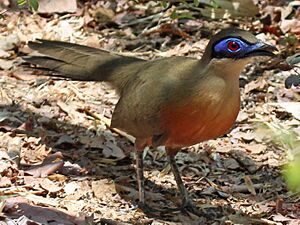Coquerel's coua facts for kids
Quick facts for kids Coquerel's coua |
|
|---|---|
 |
|
| at Kirindy Forest, Madagascar | |
| Conservation status | |
| Scientific classification | |
| Genus: |
Coua
|
| Species: |
coquereli
|
The Coquerel's coua (Coua coquereli) is a special kind of cuckoo bird. It belongs to the Cuculidae family. This bird lives only on the island of Madagascar. Its home is in dry tropical forests. A French scientist named Alfred Grandidier gave it its name in 1867. He named it after another French scientist, Charles Coquerel.
Contents
What Does Coquerel's Coua Look Like?
The Coquerel's coua is about 40 cm (16 in) long. It has a large blue patch of bare skin around its eye. This blue patch is a special sign of the Coua group of birds. It looks a bit like the African turacos.
Its feathers are very soft. The top of its head is black. Its back and tail are light brown or grey-brown. Its lower chest and belly have a reddish color. The bird's eyes are red. Its beak and legs are a grey color. Like other cuckoos, it has a special third toe that can point backward or forward. This helps it climb through thick bushes and vines. It can climb up to 10 m (30 ft) high when looking for food.
Where Does Coquerel's Coua Live?
The Coquerel's coua lives only in Madagascar. This means it is endemic to the island. It lives in the dry deciduous forests and gallery forests. These forests are found in the western part of the island. Another large bird, the giant coua (Coua gigas), also lives in this same area. The wet season in this part of Madagascar is from December to February. After that, there is a long dry season.
How Coquerel's Coua Behaves
The Coquerel's coua mostly stays on the ground. It eats mainly insects and other arthropods like spiders. It also eats some seeds. What it eats and how it finds food changes with the seasons. It might pick insects off leaves, dig in the leaf litter, or chase its prey. It can also jump or fly into the air to catch insects.
Most of the year, the Coquerel's coua lives alone. Each bird has its own area, called a home range. When the dry season is ending, the birds form pairs. These pairs are monogamous, meaning they stay together. They usually share their home ranges.
Raising a Family
Coquerel's couas breed during the wet season, from November to April. Sometimes, male birds have been seen bringing a gift, like a caterpillar or a grasshopper, to a female. But after mating, the male sometimes eats the insect himself!
Unlike most other cuckoos, this bird builds its own nest. It also sits on its own eggs and takes care of its young. The nests are built a few meters off the ground in thick plants. A female usually lays about two eggs. The eggs hatch after at least 13 days.
The inside of the young birds' mouths has a special pattern. This pattern might help the parents know where to put the food. The young birds leave the nest after about nine days. At this time, they are still covered with soft down feathers and cannot fly. They wait on the ground or in low bushes for their parents. The adult birds feed them caterpillars and crickets. The young birds leave the nest early. This might be because of the danger from predators. Some animals that might eat the eggs or young birds include the narrow-striped mongoose, the small Indian civet, the common brown lemur, and snakes like the Malagasy giant hognose. Birds like the Madagascar harrier-hawk, the cuckoo roller, and the Malagasy coucal can also be predators.
What is Its Conservation Status?
The Coquerel's coua lives in a small area in western Madagascar. Its population seems to be slowly decreasing. However, there are still many of these birds in their home range. Because of this, the International Union for Conservation of Nature says its conservation status is of least concern. This means it is not currently in danger of disappearing.


